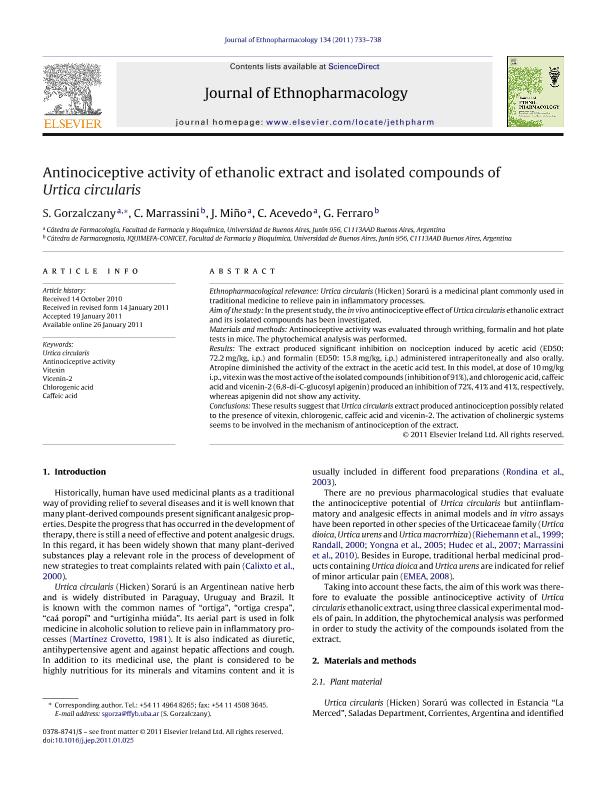Artículo
Antinociceptive activity of ethanolic extract and isolated compounds of Urtica circularis
Gorzalczany, Susana Beatriz; Marrassini, Carla ; Miño, Jorge; Acevedo, Cristina; Ferraro, Graciela Ester
; Miño, Jorge; Acevedo, Cristina; Ferraro, Graciela Ester
 ; Miño, Jorge; Acevedo, Cristina; Ferraro, Graciela Ester
; Miño, Jorge; Acevedo, Cristina; Ferraro, Graciela Ester
Fecha de publicación:
04/2011
Editorial:
Elsevier Ireland
Revista:
Journal of Ethnopharmacology
ISSN:
0378-8741
Idioma:
Inglés
Tipo de recurso:
Artículo publicado
Clasificación temática:
Resumen
Ethnopharmacological relevance: Urtica circularis (Hicken) Sorarú is a medicinal plant commonly used in traditional medicine to relieve pain in inflammatory processes. Aim of the study: In the present study, the in vivo antinociceptive effect of Urtica circularis ethanolic extract and its isolated compounds has been investigated. Materials and methods: Antinociceptive activity was evaluated through writhing, formalin and hot plate tests in mice. The phytochemical analysis was performed. Results: The extract produced significant inhibition on nociception induced by acetic acid (ED50: 72.2 mg/kg, i.p.) and formalin (ED50: 15.8 mg/kg, i.p.) administered intraperitoneally and also orally. Atropine diminished the activity of the extract in the acetic acid test. In this model, at dose of 10 mg/kg i.p., vitexin was the most active of the isolated compounds (inhibition of 91%), and chlorogenic acid, caffeic acid and vicenin-2 (6,8-di-C-glucosyl apigenin) produced an inhibition of 72%, 41% and 41%, respectively, whereas apigenin did not show any activity. Conclusions: These results suggest that Urtica circularis extract produced antinociception possibly related to the presence of vitexin, chlorogenic, caffeic acid and vicenin-2. The activation of cholinergic systems seems to be involved in the mechanism of antinociception of the extract.
Archivos asociados
Licencia
Identificadores
Colecciones
Articulos(IQUIMEFA)
Articulos de INST.QUIMICA Y METABOLISMO DEL FARMACO (I)
Articulos de INST.QUIMICA Y METABOLISMO DEL FARMACO (I)
Citación
Gorzalczany, Susana Beatriz; Marrassini, Carla; Miño, Jorge; Acevedo, Cristina; Ferraro, Graciela Ester; Antinociceptive activity of ethanolic extract and isolated compounds of Urtica circularis; Elsevier Ireland; Journal of Ethnopharmacology; 134; 3; 4-2011; 733-738
Compartir
Altmétricas



